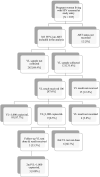Viral load testing among pregnant women living with HIV in Mutare district of Manicaland province, Zimbabwe
- PMID: 36384677
- PMCID: PMC9667426
- DOI: 10.1186/s12981-022-00480-1
Viral load testing among pregnant women living with HIV in Mutare district of Manicaland province, Zimbabwe
Abstract
Background: Viral load (VL) monitoring of pregnant women living with HIV (PWLHIV) and antiretroviral therapy (ART) may contribute to lowering the risk of vertical transmission of HIV. The aims of this study were to assess the uptake of HIV VL testing among PWLHIV at entry to the prevention-of-mother-to-child transmission (PMTCT) services and identify facilitatory factors and barriers to HIV VL access.
Methods: A retrospective, cross-sectional study was conducted at 15 health facilities in Mutare district, Manicaland Province, Zimbabwe from January to December 2018. This analysis was complemented by prospective interviews with PWLHIV and health care providers between October 2019 and March 2020. Quantitative data were analysed using descriptive and inferential statistical methods. Risk factors were evaluated using multivariate logistic regression. Open-ended questions were analysed and recurring and shared experiences and perceptions of PWLHIV and health care providers identified.
Results: Among 383 PWLHIV, enrolled in antenatal care (ANC) and receiving ART, only 121 (31.6%) had a VL sample collected and 106 (88%) received their results. Among these 106 women, 93 (87.7%) had a VL < 1000 copies/mL and 77 (73%) a VL < 50 copies/mL. The overall median duration from ANC booking to VL sample collection was 87 (IQR, 7-215) days. The median time interval for the return of VL results from date of sample collection was 14 days (IQR, 7-30). There was no significant difference when this variable was stratified by time of ART initiation. VL samples were significantly less likely to be collected at local authority compared to government facilities (aOR = 0.28; 95% CI 0.16-0.48). Barriers to VL testing included staff shortages, non-availability of consumables and sub-optimal sample transportation. Turnaround time was prolonged by the manual results feedback system.
Conclusions and recommendation: The low rate of HIV VL testing among PWLHIV in Mutare district is a cause for concern. To reverse this situation, the Ministry of Health should consider interventions such as disseminating antiretroviral guidelines and policies electronically, conducting regular PMTCT mentorship for clinical staff members, and utilising point of care testing and telecommunication devices like mHealth to increase uptake of VL testing and improve results turnaround time.
Keywords: HIV PMTCT; HIV viral load monitoring; HIV/AIDS; Human Immunodeficiency Virus; Pregnancy.
© 2022. The Author(s).
Conflict of interest statement
The authors declare that they have no competing interest.
Figures
References
-
- World Health Organization . Consolidated guidelines on the use of antiretroviral drugs for treating and preventing HIV infection recommendations for a public health approach. Geneva: World Health Organization; 2016. - PubMed
-
- Tubiana R, Le Chenadec J, Rouzioux C, Mandelbrot L, Hamrene K, Dollfus C, et al. Factors associated with mother-to-child transmission of HIV-1 despite a maternal viral load < 500 copies/ml at delivery: a case-control study nested in the French perinatal cohort (EPF-ANRS CO1) Clin Infect Dis. 2010;50(4):585–596. - PubMed
-
- Garcia PM, Kalish LA, Pitt J, Minkoff H, Quinn TC, Burchett SK, et al. Maternal levels of plasma human immunodeficiency virus type 1 RNA and the risk of perinatal transmission. N Engl J Med. 1999;341(6):394–402. - PubMed
Publication types
MeSH terms
Substances
Grants and funding
LinkOut - more resources
Full Text Sources
Medical


